Another month, another round of adding to my closed-end fund portfolio to drive up my monthly cash flow. That said, April was a more interesting month as the overall broader equity market finally had a bit of a pullback and overall volatility increased. At one point, the S&P 500 Index had pulled back just over 5% during the month. This was the first pullback in around six months, going back to the correction level the market touched last October.
The last day of trading for the month of April also saw a sharp drop ahead of the FOMC meeting, which could indicate that we aren’t in the clear yet.

YCharts
That ended up being short-lived and we are now pushing up against new all-time highs in the broader indexes.
With that, there was seemingly just enough volatility to shake up some discounts in the CEF space and make them look more appealing. While I’m still leaning toward a higher cash weighting, it offered some further opportunities to use that cash over the last month compared to the prior month. Overall, I added to five different names this month, but all were previously held positions.
Nuveen AMT-Free Municipal Value Fund (NUW)
I kicked off this month by adding to my NUW position. Along with buying Western Asset Investment Grade Income Fund (PAI) regularly over the last year or so, I’ve been buying NUW based on its attractive valuation, non-leverage and higher-quality allocations to fixed-income.
These are going to be more interest-rate-sensitive investments, and that means risk-free yields are really going to drive their price movement. We are looking at a scenario of “higher for longer” as inflation remains sticky. At the same time, the Fed isn’t expected to hike their short-term target rate any further, this is subject to change based on data coming in. If that is any indication of what moves the longer-term risk-free rates might do, which they very loosely tend to do but with more volatility, most of the damage should be in.
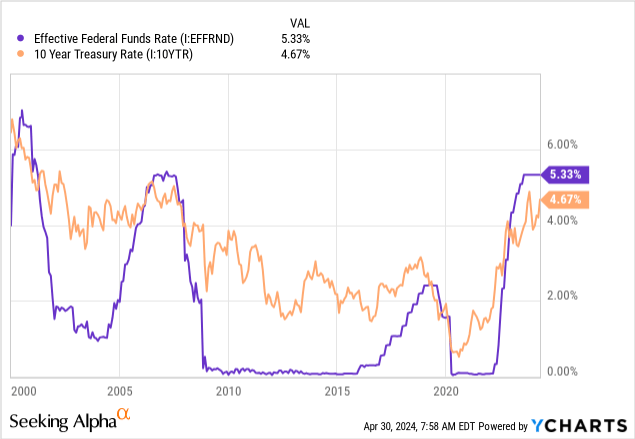
YCharts
If that ends up being the case and most of the damage is in, then I’m happy to collect relatively secure income and de-risk my portfolio overall with these names. In general, I hold significant exposure to highly leveraged CEFs primarily invested in equities or below-investment-grade fixed-income. The main play on these is accepting a lower yield for lower risk but some potential appreciation in the future if rates head lower.
BlackRock Enhanced Equity Dividend Fund (BDJ)
BDJ is a fund I cover regularly and had done just in March for a really recent update. This is also one of the largest positions in my CEF portfolio. The fund focuses on a value-oriented portfolio as it benchmarks against the Russell 1000 Value Index while also employing a covered call strategy. That is where the other benchmark comes in, the MSCI USA Value Call Overwrite Index.
Outside of the Global Financial Crisis, the fund has provided a rather regular and predictable monthly distribution to investors.

BDJ Distribution History (CEFConnect)
With a current distribution rate of 8.41%, while the fund’s NAV rate is 7.37%, the meaningful difference here is thanks to the fund’s discount. That discount has been widening out substantially over the last year. That is precisely why I have once again been adding to my BDJ position as it trades at this attractive valuation. It’s trading below its long-term average discount of around 8%.
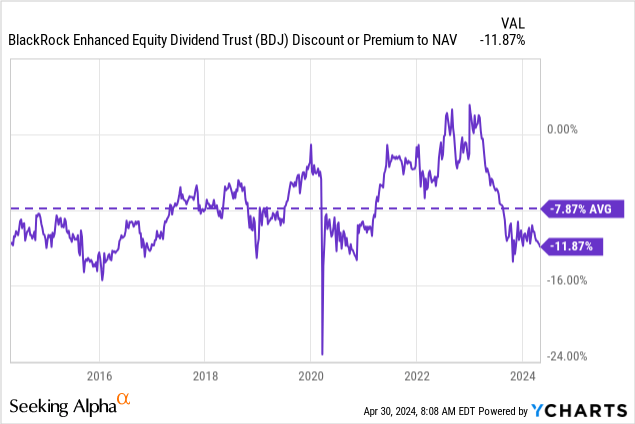
YCharts
XAI Octagon Floating Rate & Alternative Income Trust (XFLT)
Speaking above, when touching on NUW about investing in meaningful allocations of CEFs focused on below-investment grade while also employing leverage comes XFLT. The fund invests primarily in senior loans and CLOs, both equity and debt tranches, with rather negligible exposure to other asset classes.
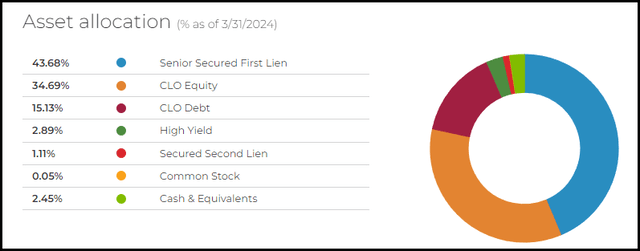
XFLT Portfolio Breakdown (XAInvestments)
This is a perfect example of a higher risk but potentially significantly higher reward. XFLT yields around 14.50%, and it is earning its payout through the income generated on its portfolio, as highlighted in a recent update. However, with defaults on the rise and carrying ~40% leverage, that could cause some issues in the future if the economy turns sour.
For now, it’s been pretty smooth sailing, and the valuation isn’t overly rich. The fund trades at a premium, but that tends to happen with XFLT, which is presumably why shareholders somewhat recently voted to allow XFLT to remove its term structure and convert it to a perpetual fund. Based on the average premium for the duration of the fund’s life, we are actually trading just about there right now.
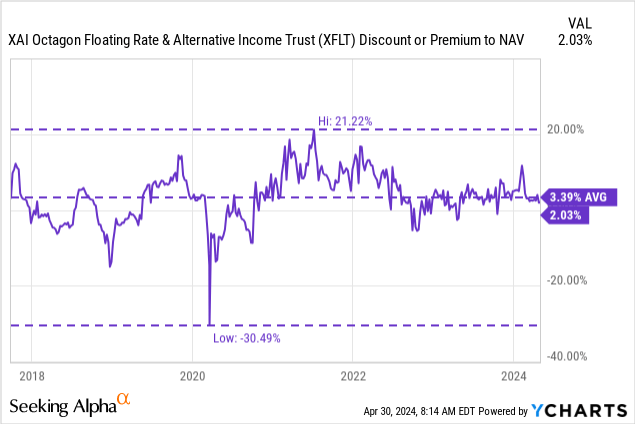
YCharts
BlackRock Health Sciences Trust (BME)
This is a fund where volatility seemingly has sent this fund’s valuation to a deep discount. The fund historically very rarely trades at a discount over most of the last decade, but over the last year, the fund has experienced sizeable discounts. Once again, it has come to a sizeable level, as we highlighted earlier in the month. The discount has narrowed some since then but still remains at an attractive valuation, in my opinion.
Over the last decade, BME has generally traded at a premium, on average. That doesn’t mean that it is guaranteed to return to that level, but it does tend to suggest that the downside could be more limited in terms of widening further from here.
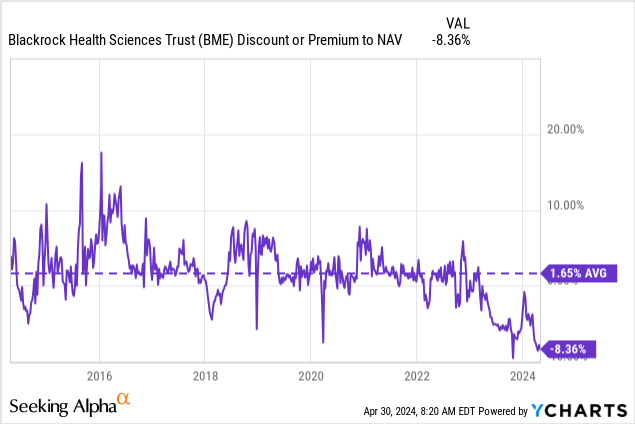
YCharts
Similar to BDJ and CII (which I’m touching on next,) the fund employs a covered call strategy. In this case, BME, as the name would suggest, is focused specifically on healthcare exposure. Given the generally steady nature of the healthcare space, it has allowed BME to offer a generally steady distribution to investors.
In fact, the fund has never reduced its regular distribution to investors, even while the fund hit the market prior to the GFC. There are only a handful of other CEFs that can boast that same feat.
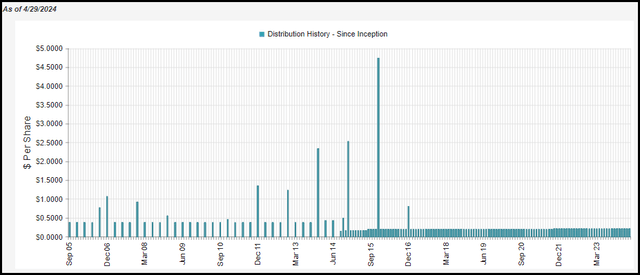
BME Distribution History (CEFConnect)
BlackRock Enhanced Capital and Income Fund (CII)
CII is another fund from the BlackRock suite that has also moved to a substantial out-of-character discount based on its historical trading levels. It isn’t that the fund’s portfolio is performing terribly, either.

YCharts
Year-to-date, the fund’s portfolio, as measured by the fund’s total NAV returns, is up 5.36%. At the same time, the total share price returns are flat, hence the fact that the fund has moved to a larger discount more recently.
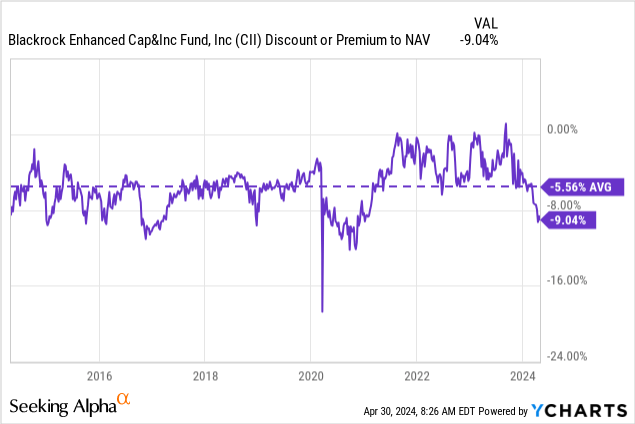
YCharts
CII employs a covered call strategy, which can limit some upside potential in rapidly appreciating markets. However, for the most part, CII is invested in a portfolio that mostly reflects the broader market as a companion fund to BDJ but is focused on the Russell 1000 Index. It also delivers a higher relative yield when compared to the broader market, thanks to the distribution of capital gains from its underlying portfolio and those generated from the covered calls.
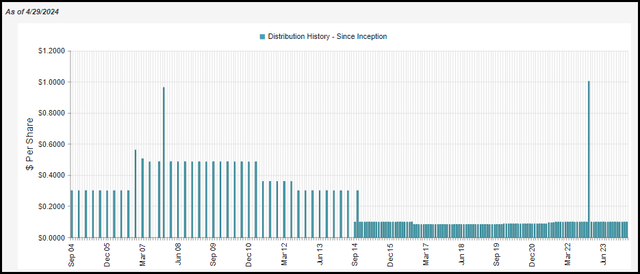
CII Distribution History (CEFConnect)
With the fund moving to a meaningful discount, the distribution rate is 6.41%, but the NAV rate is 5.83%. That may not be that high compared to some other CEF peers that target ~10% distribution levels, but this does allow for a couple of things that should be noted.
Either the fund is going to see some appreciation, or at the very least likely, it should stay above its inception NAV over reasonable periods of time, which some investors appreciate. This is because the fund, in my opinion, has a high likelihood of earning its payout to investors. Alternatively, the fund could look to see its distribution increased from here, which may garner more interest from investors and see its discount narrow.
Another factor to consider is that with a lower relative yield compared to some other equity CEFs, it’s in a position where it has more downside cushion. Even if a market correction happens, it could lead to the fund maintaining its distribution for a longer period of time or avoiding cuts altogether when others could be cutting as they are already on the higher end of the payout rate spectrum.
Read the full article here









Leave a Reply